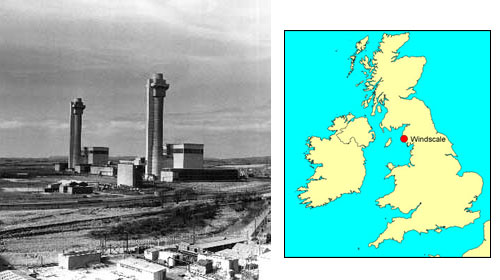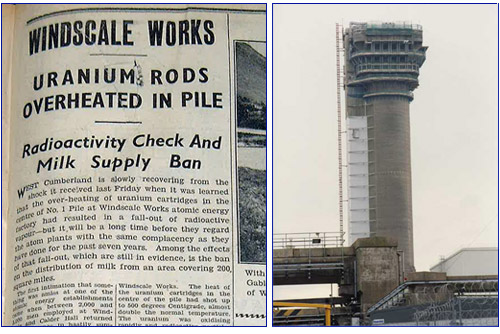Windscale : an accident of the U.K nuclear weapon program (1957)
The fire which occurred the 10th of October 1957 on the Windscale site along the Irish Sea in England is an accident of the British military nuclear program at its beginnings. This accident happened on one of the reactors (referred as atomic «piles» at that time) supplying in plutonium the United Kingdom arsenal of atomic bombs.

Atomic piles to produce plutonium
The tall chimney of ”Windscale piles” in the English countryside of Cumbria. Post war technology limits implied that the shortest route to produce plutonium for an atomic bomb was to build a reactor using natural uranium as fuel, moderated with graphite and cooled with air. Thus, in 1946 the construction of two reactors known as the Windscale piles was launched at a former munitions factory in Sellafield. In a remarkably short time, the first reactor was commissioned in October 1950, the second one eight months later.
© BNFL
To remain a great power, England had decided to launch in 1945 a program to produce plutonium for atomic bombs. So far, Great Britain had collaborated with the Americans, but Americans decided to stop any sharing of information on weapons with another country. A program had been started urgently in 1946 to produce plutonium for atomic «piles». Thus the two reactors of Windscale were quickly built and England could have plutonium in March 1952 for its first bomb.
Atomic piles using natural uranium were moderated with graphite and cooled with air . These last two factors were the cause of the fire on the nuclear pile No. 1 in 1957 which caused a release of radioactivity outside the site. The Windscale accident is classified at level 5 on nuclear accident scale of severity, the same level as the Three Mile Island accident, Chernobyl being located at level 7.
The accident was due to the lack of knowledge engineers and physicists had at that time about the behavior of graphite irradiated at relatively low temperatures. Since the startup of the «piles», they had observed spontaneous release of energy. To prevent dangerous rises in temperature due to the uncontrolled pile core, periodic « annealings » should be conduct. These procedures were effective but still poorly understood. The sixteenth, which occurred on nuclear pile No. 1 the 10th of October 1957, took place in a disastrous way. A too rapid release of energy triggered off a dreaded fire. Fission products were released into the atmosphere. Thanks to the heroic efforts of operators, the fire was finally under control and a disaster narrowly avoided.

Restrictions on milk consumption
Headline of a British newspaper : « Uranium rods overheated in in pile. Control of radioactivity check and « milk supply ban « . Authorities had to limit consumption of locally produced milk. A ban on milk was thus imposed on October 12 for a short period of time. The main concern was the presence in milk of iodine 131, a radioactive isotope of 8 days half-life. The cores of the two piles were unloaded after the fire, with the exception of 15 tonnes of fuel in the damaged area. The removal of these 15 tons was undertaken in 1999 by UKEA (the UK CEA) as part of the decommissioning of Windscale.
© BNFL/UKEA
When it was discovered that radioactivity, and specially iodine-131, had been released into the atmosphere, steps were taken to prohibit milk consumption in a 200 square miles area around Windscale. These measures, the first of their kind, had the effect of reducing the health consequences of the accident.
Although there is still controversies about the amount of radioactivity released and the effects of these discharges, the most pessimistic estimations lead to a certain number of deaths due to radiation that can however not be distinguished from other causes.
Such a fire now old of 50 years could not happen again today, even with the English reactors like Magnox or AGR still using graphite as moderator. Indeed, the air which cooled Windscale «piles» and supplied graphite combustion is now replaced by carbon dioxide gas that smothers the burning. Moreover, moderated graphite reactors operate at high temperatures that eliminate inopportune heat releases. Finally, contrary to nowadays, there was no containment wall at Windscale in 1957, cooling air being directly released into the atmosphere.
Other articles on the subject « Nuclear Accidents »
The INES scale
The severity scale of nuclear accidents Nuclear installations and their operation are complex and[...]
Accidents of radioactivity
The importance of a close monitoring of radioactive sources… In many countries, the possess[...]
Accident Causes
Human errors, design flaws and natural cataclysms A nuclear accident dwarfs all other types of ac[...]
Mayak Accident
A military long-hidden nuclear accident of the Soviet era Long before Chernobyl, it was suspected[...]
Three Mile Island
1979: A major accident that led to the destruction of a reactor The Three Mile Island plant (TMI)[...]
Tokaimura Accident
1999 : a « criticity » accident in Japan This surprising accident of « criticality » came about i[...]